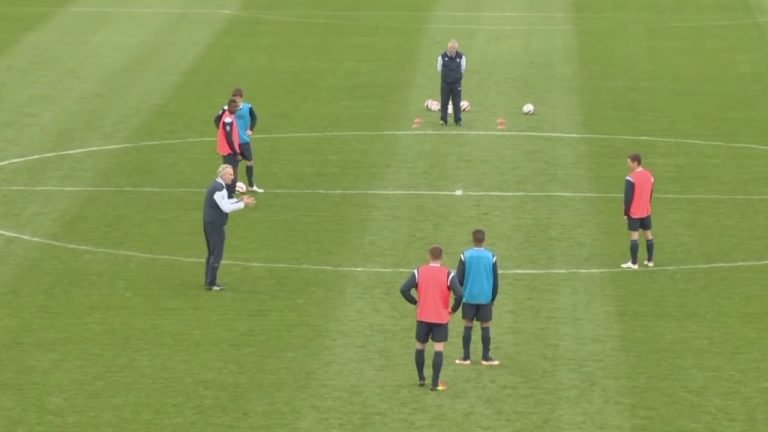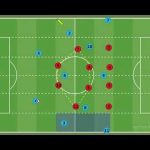In the world of soccer, being a striker is not just about scoring goals, but also about anticipating and reacting to defensive pressure. As the focal point of the team’s attack, a striker must possess the ability to read the game, make split-second decisions, and outsmart the opposition’s defensive line. In this article, we delve into the art of being a striker who not only finds the back of the net but also navigates through relentless defensive pressure with finesse and skill. Whether it’s using clever movement, exploiting gaps, or showcasing impeccable ball control, we explore the secrets behind becoming a formidable force in the face of defensive challenges.
What is the role of a striker in defense?
A striker’s responsibilities extend beyond scoring goals. When it comes to defense, a striker plays a vital role in disrupting the opposition’s progress. By pressing the defense and midfield, strikers can effectively halt the advancement of the ball, forcing the opposition to make mistakes and lose possession. This defensive pressure not only protects their own team’s goal but also creates opportunities for counterattacks.
However, defending as a striker requires more than just pressing. A striker must also possess the ability to track back and support their teammates in defensive situations. This means being aware of the movements of the opposition’s attackers and midfielders and quickly reacting to potential threats. By actively contributing to the defensive efforts of the team, a striker can help create a solid defensive unit that is difficult for the opposition to penetrate.
To excel in both attacking and defensive duties, a good striker must have exceptional stamina. They need to be able to maintain a high level of performance throughout the entire 90 minutes of a match. This endurance allows strikers to constantly apply pressure, both offensively and defensively, and make decisive contributions to the team’s overall gameplay. A well-rounded striker who can effectively defend while also being a constant threat in the attacking third is a valuable asset to any team.
What does defensive pressure in football refer to?
Defensive pressure in football is the strategic art of confining the attacking team’s options, forcing them to act swiftly and assertively in order to find gaps, exploit opportunities, and maintain ball control. By limiting space and applying intense pressure, the defending team aims to disrupt the attacking team’s flow, prompting quicker decision-making and ultimately making it harder for them to execute their game plan effectively. This cohesive defensive effort not only aims to thwart the opponent’s progress but also creates an enticing spectacle for spectators, as players battle against the constraints and strive to outmaneuver their opponents.
Can strikers play defense at any time?
Strikers, known for their attacking prowess and goal-scoring abilities, are often perceived as players who solely focus on the offensive side of the game. However, it is not uncommon to witness strikers actively contributing to the defensive efforts of their team. While their primary responsibility lies in finding the back of the net, strikers with a strong work ethic and tactical understanding can also excel in defensive duties. They can be seen pressuring opponents, tracking back to win possession, and even making crucial tackles in their own half. This versatility showcases their commitment to the team’s overall success and proves that strikers are not just one-dimensional players.
Contrary to popular belief, strikers are not limited to just scoring goals but can also make impactful defensive contributions. By seamlessly transitioning from attack to defense, they effectively disrupt the opponent’s build-up play, create turnovers, and provide valuable support to the backline. This multi-faceted approach not only showcases the versatility of strikers but also highlights their importance in maintaining a balanced and cohesive team structure. So, while their primary objective remains finding the back of the net, it is evident that strikers can indeed play a vital role in the defensive aspect of the game.
Unleash Your Inner Striker: Mastering Defensive Pressure
Unleash Your Inner Striker: Mastering Defensive Pressure
In the game of soccer, defensive pressure is the key to success. It is the art of disrupting the opponent’s rhythm and forcing them into making mistakes. To master defensive pressure, one must possess the instincts of a striker. Just like a ruthless striker goes for the goal, a dominant defender goes for the ball, constantly pressuring the opposition and denying them any breathing space. By unleashing your inner striker, you can become a defensive force to be reckoned with, turning the tide of the game in your team’s favor.
To truly excel in defensive pressure, it is crucial to understand the importance of timing and anticipation. Like a skilled striker, you must read the game, analyze the movements of your opponents, and pounce at the right moment. By applying relentless pressure at the right time, you can force your opponents into making errors and seize control of the game. Mastering defensive pressure is not just about physical strength and speed, but about the mental agility to outwit your opponents and disrupt their game plan. So, unleash your inner striker, sharpen your defensive instincts, and become a formidable force that strikes fear into the hearts of your adversaries.
The Art of Anticipation: A Striker’s Guide to Defensive Pressure
Paragraph 1:
In the exhilarating game of soccer, anticipation is a key skill that sets top strikers apart from the rest. The art of anticipation allows strikers to read and react to defensive pressure, creating opportunities to score goals. By studying the movements of opposing defenders and analyzing their patterns, strikers can position themselves strategically, ready to pounce on any defensive mistake. The ability to anticipate defensive pressure is like having a sixth sense on the field, and it is a skill that every aspiring striker should master.
Paragraph 2:
To become a proficient striker, it is essential to understand the various types of defensive pressure and how to exploit them. When facing high-pressure defenses, strikers must anticipate quick passes and make swift, decisive movements to outmaneuver their opponents. Against deep-lying defenses, the art of anticipation lies in finding gaps and spaces within the defensive line, positioning oneself to receive the ball and create scoring opportunities. By studying game footage and developing a deep understanding of defensive strategies, strikers can enhance their ability to anticipate and exploit defensive pressure effectively.
Paragraph 3:
The art of anticipation goes beyond individual skill; it also involves communication and synergy with teammates. Strikers must develop a telepathic understanding with their fellow forwards and midfielders to anticipate their movements and make accurate runs and passes. By effectively communicating and coordinating offensive actions, strikers can disrupt the defensive organization and create goal-scoring chances. The art of anticipation is not just about the individual; it is a collective effort that requires teamwork and cohesion among all players on the field.
Subtitle: The Art of Anticipation: A Striker’s Guide to Defensive Pressure
Reacting with Precision: Unlocking the Secrets of Defensive Pressure
Reacting with precision in the game of basketball is a critical skill that can make all the difference on the court. Unlocking the secrets of defensive pressure requires a combination of quick thinking, agility, and coordination. By studying the movements and tendencies of opponents, players can anticipate their next move and react swiftly to shut down their offensive plays. This level of defensive precision not only disrupts the flow of the opposing team but also instills fear and uncertainty, giving the defending team a significant advantage. With relentless focus and a commitment to mastering defensive techniques, players can unlock the secrets of defensive pressure and become formidable forces on the court.
To thrive as a striker, it is imperative to possess the ability to anticipate and react to defensive pressure. By staying one step ahead of opponents, a skilled forward can find the gaps, exploit weaknesses, and create scoring opportunities for themselves and their team. With quick thinking, sharp movements, and a calculated approach, strikers can keep defenders guessing and maintain a constant threat in the attacking third. Mastering the art of anticipating and reacting to defensive pressure allows strikers to be effective game-changers and indispensable assets to their teams.



